Lower Chesapeake Bay Fishing Report, August 30, 2019 Update:
Although high wind and overcast days put a damper on many anglers fishing plans early this week, those who managed to get out on the water continued to enjoy an epic Spanish mackerel bite. The fish aren’t just here or there, they’re everywhere, from the Middle Grounds south clear to the CBBT and the Way South Chesapeake zone. They are moving, though, and the anglers doing best are covering water at eight or nine knots with number-one planers deployed until they find the fish, then sticking to the area. Small gold Clarke spoons, pink and yellow Hard Head Custom Baits, and small Drones pulled 15 to 20 feet behind the planers are doing the trick. The pink and yellow Hard Head Custom Baits have been a favorite for many anglers. A reader report from a trip out of Reedville put the count at dozens and dozens - and dozens - of fish. The Tackle Box suggested anglers running from up the Potomac hit up the down-river channel edges before cruising all the way out to the shipping channel and main-stem Bay, which has been a common move for many trollers in this neck of the woods, as the mackerel have moved in here as well.
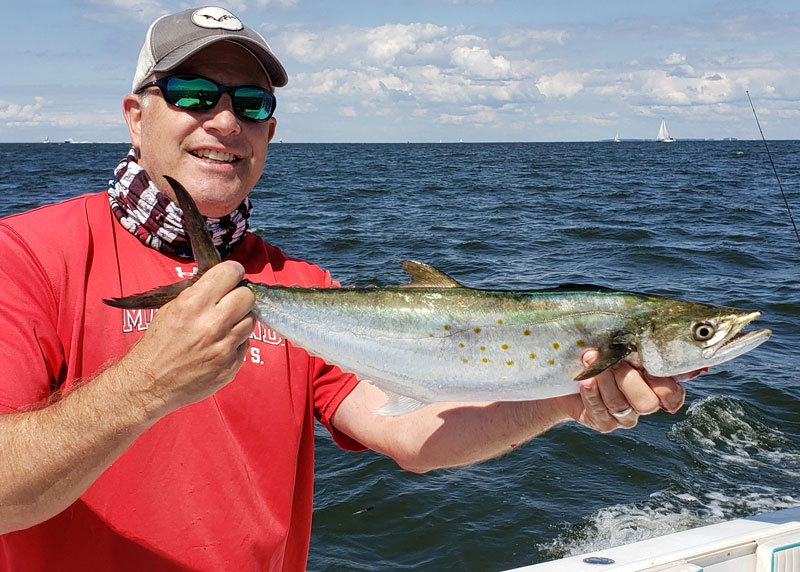
Aside from trolling, Spanish mackerel can also be caught by locating diving birds and breaking bait. Tossing a metal lure into the mix and reeling fast has landed solid fish for plenty of guys. From Smith Point north in particular the birds-and-baits combo has also been holding schools of small rockfish, which are easily caught on BKD or Gulp! lures ran through the commotion. The small stripers have also been common in the Potomac from Piney Point to St. Georges Island, and are mostly being caught by live-lining spot. Which, by the way, are just about everywhere on hard bottom in the eight- to 15-foot range. Anglers focusing on them with bloodworms on bottom rigs are finding plenty of eating-sized spot, too, with a few croakers mixed in.
Back to trolling: other trollers have been attempting to land cobia, by pulling red and green hoses. Results have been mixed at best, but the Target Ships and Middle Grounds, the mouth of the Pocomoke, Wolf Trap, and the channel edges leading south from there are all producing with some level of consistency. However, many anglers are finding mostly undersized fish. Contributor Eric Packard took a shot for them this week and had two throwbacks, both of which hit red hoses. There are also plenty of anglers searching for cobia with their eyes and live eels or large bucktails dressed out with plastics, but conditions were often difficult for sight-anglers particularly early this week and the bulk of the action for these fish remains to the south near the mouth of the Bay from Cape Charles down.
Crabbing report: Crabbing has been excellent in the tribs. Trotliners are doing especially well, so long as they’re using fresh bait. Chicken necks have been the most popular choice.
Lower Chesapeake Bay Fishing Report, August 23, 2019 Update:
How many ways are there to cook a mackerel? I imagine this is the question many anglers hitting the waters of the Lower Chesapeake must be asking right now. Anglers based here continue enjoying some of the best fishing the Chesapeake has ever seen. Most newsworthy has been the crazy run of Spanish mackerel the region is still experiencing. Might 2019 be the very best Spanish mack season in memory? Yes, it might. The Tackle Box let us know that the water has been packed with boats attempting to fill their fishboxes. Most anglers going after the Spanish mackerel have been trolling planers with gold and silver Clarke spoons, Drones, and Hard Head Custom Baits in yellow and pink. Silver/green combos have also been in the reports. All of these have a solid following and are working well, though the fish's preference seems to change day by day so it's smart to start with a mix of spoons and change them up as you discover what the fish are hitting. Sticking to the shipping channels and their edges, as well as the Middle Grounds, Smith Point, Stingray Point – heck, just about everywhere – has been incredibly productive and many boats are filling their fish boxes quickly as the action has been fast-paced and high-intensity. Many of the Spanish mackerel are high-grade and fun to fight.
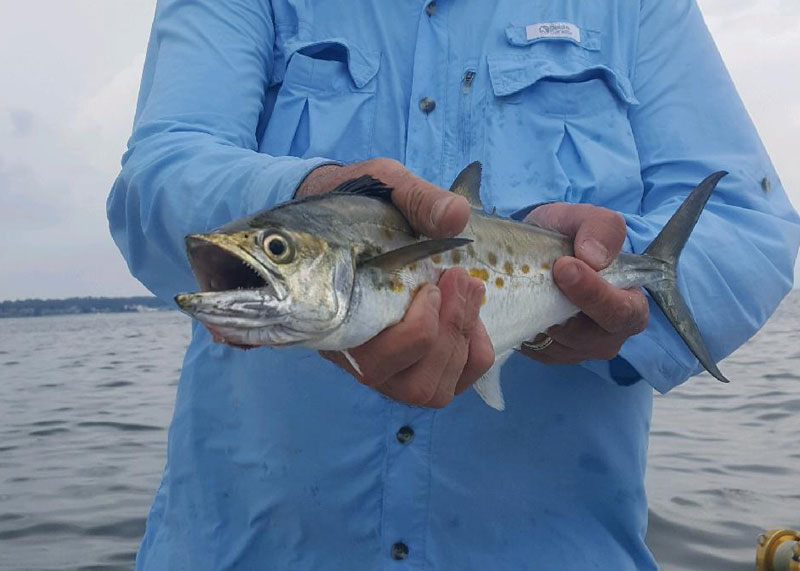
Some anglers plying the Potomac remain focused on the striper fishing, which is solid between St. Georges Island and Piney Point, particularly for liveliners. The fish have varied greatly in size, but are abundant. Luckily for liveliners, the Potomac has also been home to a booming spot population. They’re easy to find on a hard bottom with eight to 10 feet of water. Their favorite food is bloodworm, and putting them on a bottom rig is sure to land you plenty. When you’re loading up before heading out, be sure to have your depth finder on and don’t stick to an area that isn’t producing. Spot school, and once you get into them you should be headed out to catch stripers in no time.
Unfortunately, this cobia season has failed to pick up significantly and while fish are being found by those targeting them, is fairly lackluster compared to the past few summers. Most of the fish are undersized, and we haven’t seen a significant influx of larger keepers as we move into the end of August. The most common tactics for targeting them have been sight-casting and chumming while using live eels for bait. Thanks to bluefish, however, running out of eels before landing a cobia hasn’t been uncommon. For this species, farther south has been better. Trollers are making sure to include a surgical hose or two in the spread, so they have a shot at 'em.
Red drum are showing up here and there, but not in huge numbers nor any reliable spot. A few guys have been catching them jigging plastics and spoons under and around breaking fish.
Crabbing Report: Crabbing has been stellar. The haul has been rewarding and trips somewhat short-lived, as a few hours has been all that is necessary to fill a bushel basket.
Lower Chesapeake Bay Fishing Report, August 16, 2019 Update:
The Tackle Box told us there’s still time to catch the huge red drum you’ve been hearing about in the Lower Bay. They said near the Target Ship, fishing around mackerel and birds, you will have a chance at hooking one up. Look for larger marks on your fish-finder under the mackerel and drop a heavier spoon down deeper to hook up on the reds. The Tackle Box also said the mackerel bite has continued to be fantastic, plus people have found some blues trolling small spoons behind number-one and number-two planers.
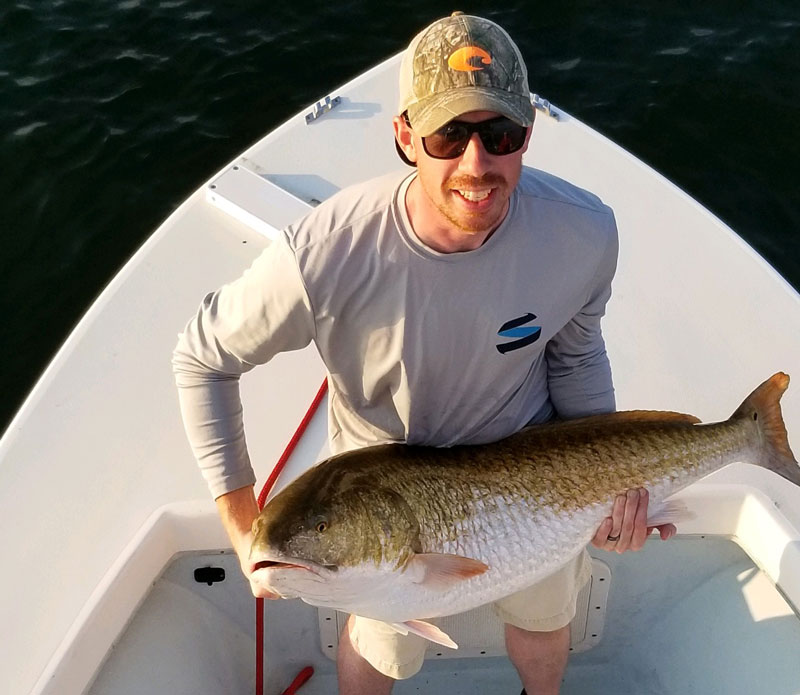
The mackerel bite is also keeping plenty of wind in the sails for anglers trolling the same gear in the Smith Point to Windmill point zone. Catches counted by the dozens are not uncommon, for Lower Bay anglers. Savvy anglers are adding a hose or two into the spread, to have a shot at cobia as well. Focusing on cobia has become tougher, not easier, however, and many of the fish we heard about this week were on the small side; one reader report from Deltaville noted that out of five fish caught on a recent trip, only one was (just two inches) over the 40-inch mark. As has been the case recently, generally speaking farther south is better, however, trollers using hoses have picked some up as far up as between 72A and Smith Point.
There's also been a nice increase in the action on the Eastern side, including in the shallows. Check out the Tangier and Lower Eastern Shore report, for more on that zone.
Lower Chesapeake Bay Fishing Report, August 9, 2019 Update:
As Ken from The Tackle Box put it, “excellent fishing continues.” Fishing in the Lower Bay has been absolutely stellar, inspiring envy in anglers north and south of its waters. Anglers located in the region have actually been complaining about the number of times in a week they’re eating Spanish mackerel. We think that’s absurd, and we invite them to send some more of those macks to neighboring waters. If you aren’t already all tuckered out from reeling ‘em in every day or are just getting out on the water, here’s the 411: make sure you’re all stocked up on silver and gold Clark number-one spoons. Trolling them 20 feet behind number-one planers just about anywhere in the Lower Bay earns you a solid shot at landing Spanish Mackerel. It’s been that easy.
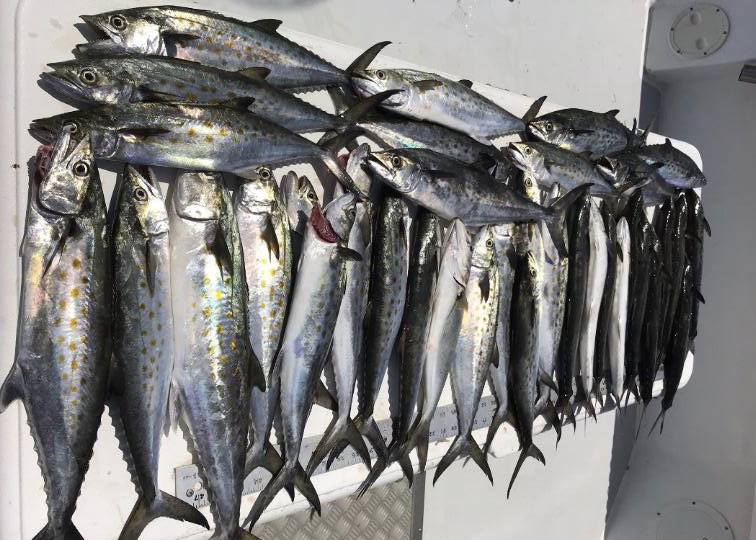
Mixed in with the mackerel you’re oh-so-eager to catch are typically small bluefish, ranging from 18 to 22 inches. They’ve been moving with the mackerel, and are usually around when they are. They’ll also snatch up your spoons, so if you’re looking to target them, do no more. Mackerel fishing, at least in my eyes, has been so freakin’ cool because so many other species follow where they go. Going after them is really like going after a surprise goodie-bag of fish, and bull redfish and cobia are both now being reported at the Middle Grounds under or around those macks and blues in greater numbers by the day. The redfish bite is particularly exciting and we had one report of a boat landing seven in one day last week. Throwing a large silver spoon in your spread and running it 15 to 20 or so feet down is a great way to entice them. Cobia will grab a red or green hose if you keep one in the spread, and you can spot them lulling on the surface or in the wake of your boat in time to take a cast before they swim away. That said, reports put the cobia numbers north of the mouth of the Bay at unimpressive levels and those that are spotted have often already been poked and prodded at by multiple fishermen at this point in the season, so sight-fishing for them has been tough. If you really want to focus on this species, the recommendation is to head for the Way South region or work coastal waters where their numbers have been up recently.
Fishing in the Tribs has been great for anglers looking to get in on some low-impact, low-effort fishing. Spot are biting almost everywhere that has a hard bottom and between eight and 15 feet of water. Anglers have been enjoying the steady action they provide and there have been some nice eating-sized fish. Some (mostly small) croaker are mixed in. In the past week, white perch fishing farther up the tribs has been dominated by large fish, most eager to strike Beetle Spins and small twisters or Roadrunners at daybreak and dusk.
Crabbing Report: Crabbing has been consistent throughout the lower regions of the Bay. Sea Hawk Sports Center mentioned the importance of using fresh chicken necks or razor clams on your trotline, and minimizing bait re-use if you strike out. Larger crabs are holding between 10 and 17 feet.
Lower Chesapeake Bay Fishing Report, August 2, 2019 Update:
Fishing in the Lower Bay continues to be stellar, and the waters are stocked with a variety of species. Hot news continues to be of the Spanish mackerel bite from the Target Ship to the Middle Grounds, which has been killer for anglers trolling small gold or silver Clark spoons behind number-one planers. Mass quantities of (small) bluefish are also mixed in with them. But there’s more: several monster-mega red drum have showed up under the breaking fish in the past few days, for those deep-jigging spoons in this zone and a bit farther down the Bay. We haven't yet heard of anyone running into a mass school of these fish, but one-sies and two-sies have popped up on at least a half-dozen-plus occasions.
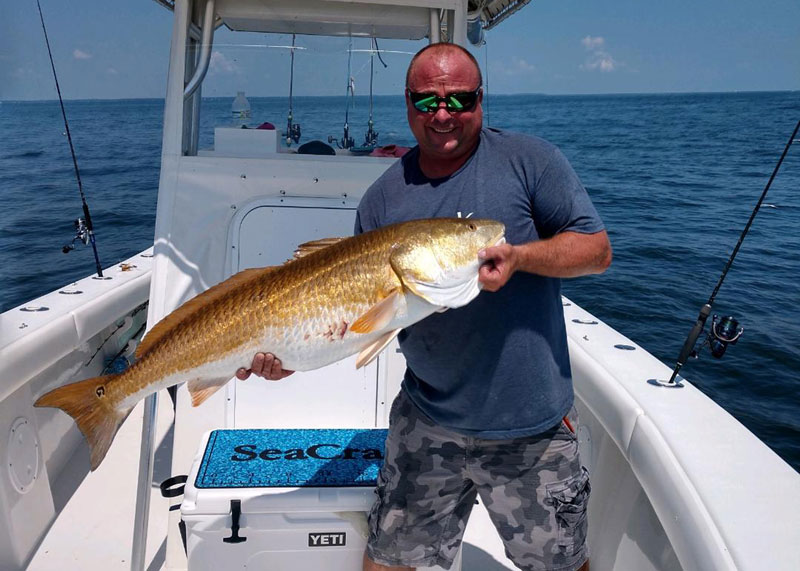
A cobia bite also hasn’t been out of the question for trollers who keep a red or green surgical eel in their spread, but cobia fishing in general has been better the farther south you go. Oceans East tackle shop noted that as well as around the Middle Grounds and south of the Target Ships, the area between Smith Point and the Stingray zone has been on fire. These areas have also been holding plenty of Spanish and blues, plus a few cobia that are likely to take trolled surgical eels and live eels in a chum slick. Sight-casters are having limited success, however, and chummers are now experiencing the plight of the bluefish and are struggling with stolen or chopped baits.
The Tackle Box let us know that the striper bite is on along channel edges and drop-offs in the Potomac River, at St. George’s and Point Lookout. They suggested trolling a white bucktail with a black head. Stripers can be found on all structure, under piers and on the rocks. Bomber Wind Cheaters in the blue-silver and Hard Head Custom Baits popping rigs have been what the rockfish are taking. Plenty of guys have been opting to live-line as well, and are enjoying a healthy spot bite in the Potomac, or over in the Sounds to load up on bait before heading out. However, they also note that overbearing heat has been putting stress on fish, causing them to become lethargic at times during mid-day.
Oddballs of the week: we've heard from anglers catching ribbonfish down at the mouth of the Bay, which isn't crazy. BUT, but, but - reports have also come in off the mouth of the Rappahannock and in the Potomac(!) We also heard from anglers who have spotted flying fish (yes, flying fish) as far up as Smith Point. Talk about weird!
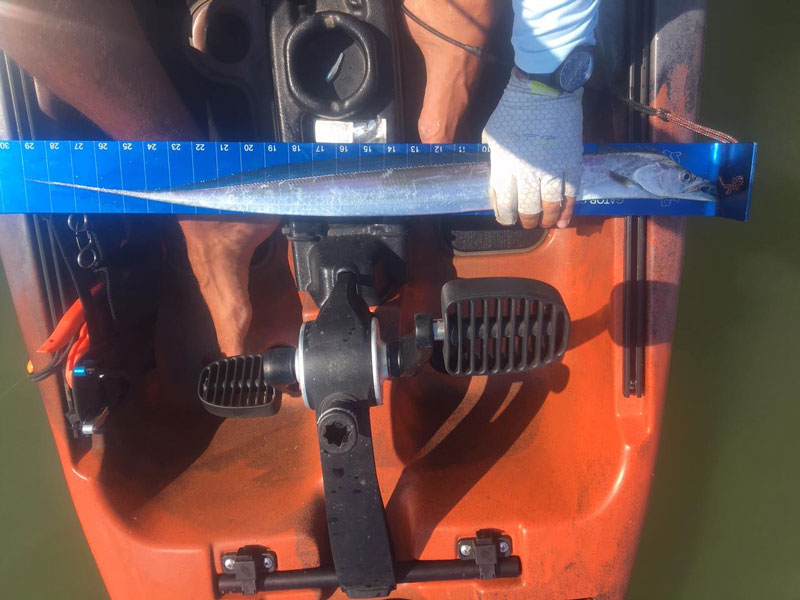
Crabbing Report: Crabbing is HOT in the lower bay. Crabbers using fresh chicken necks on a trot-line have been able to limit out on crabs consistently. Again, the key is using *fresh* bait, not recycling last weeks’ chicken necks.